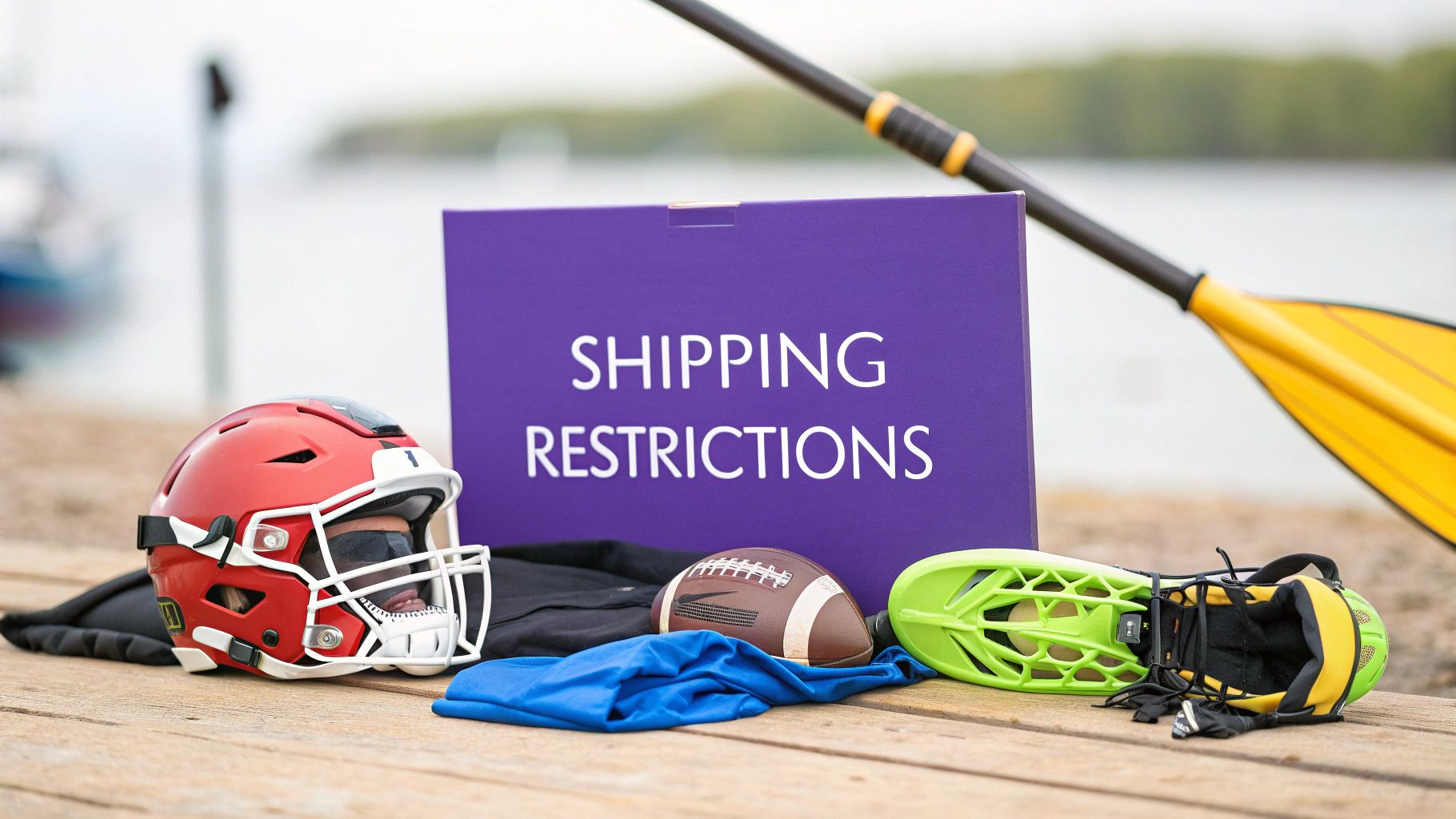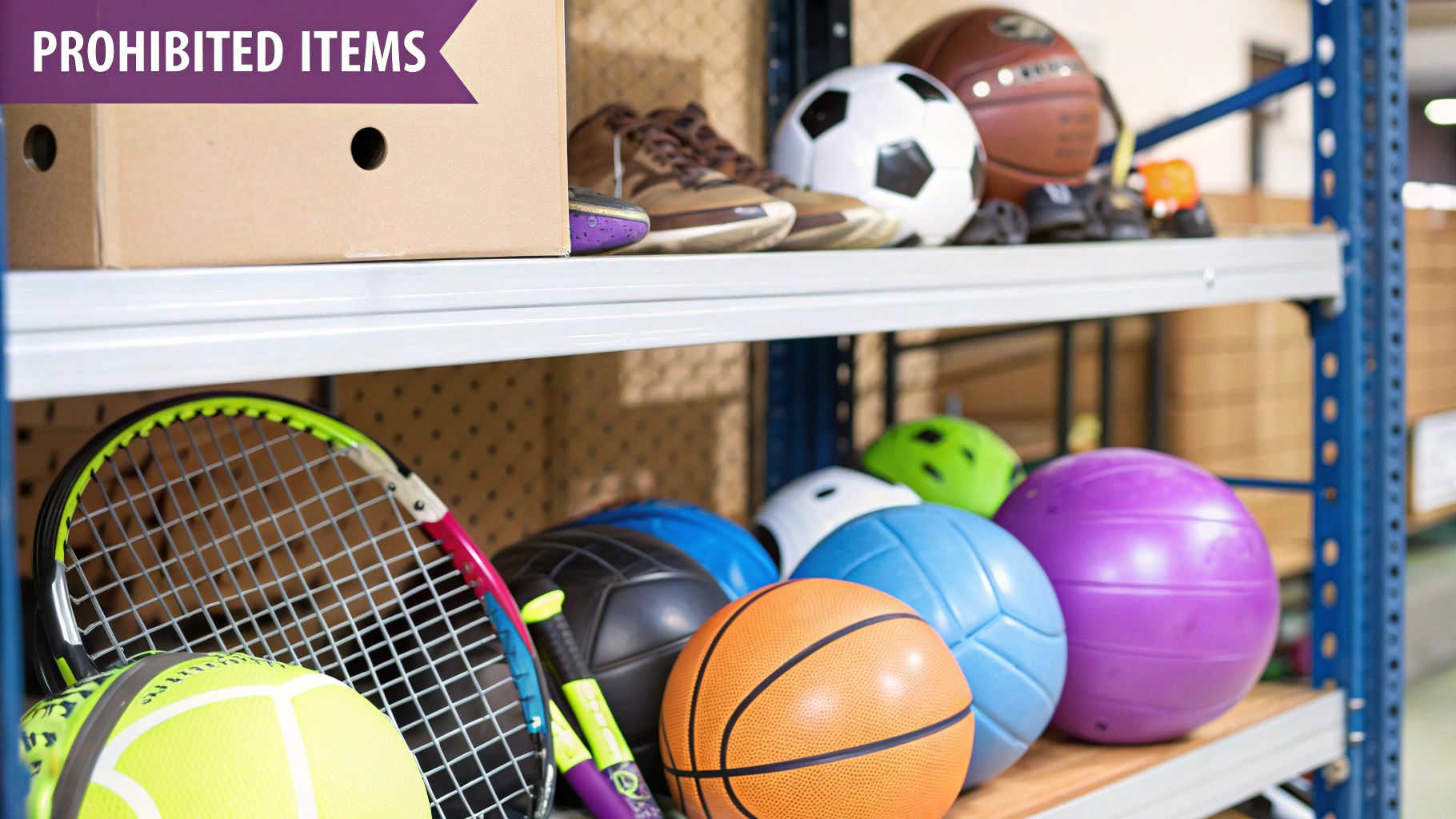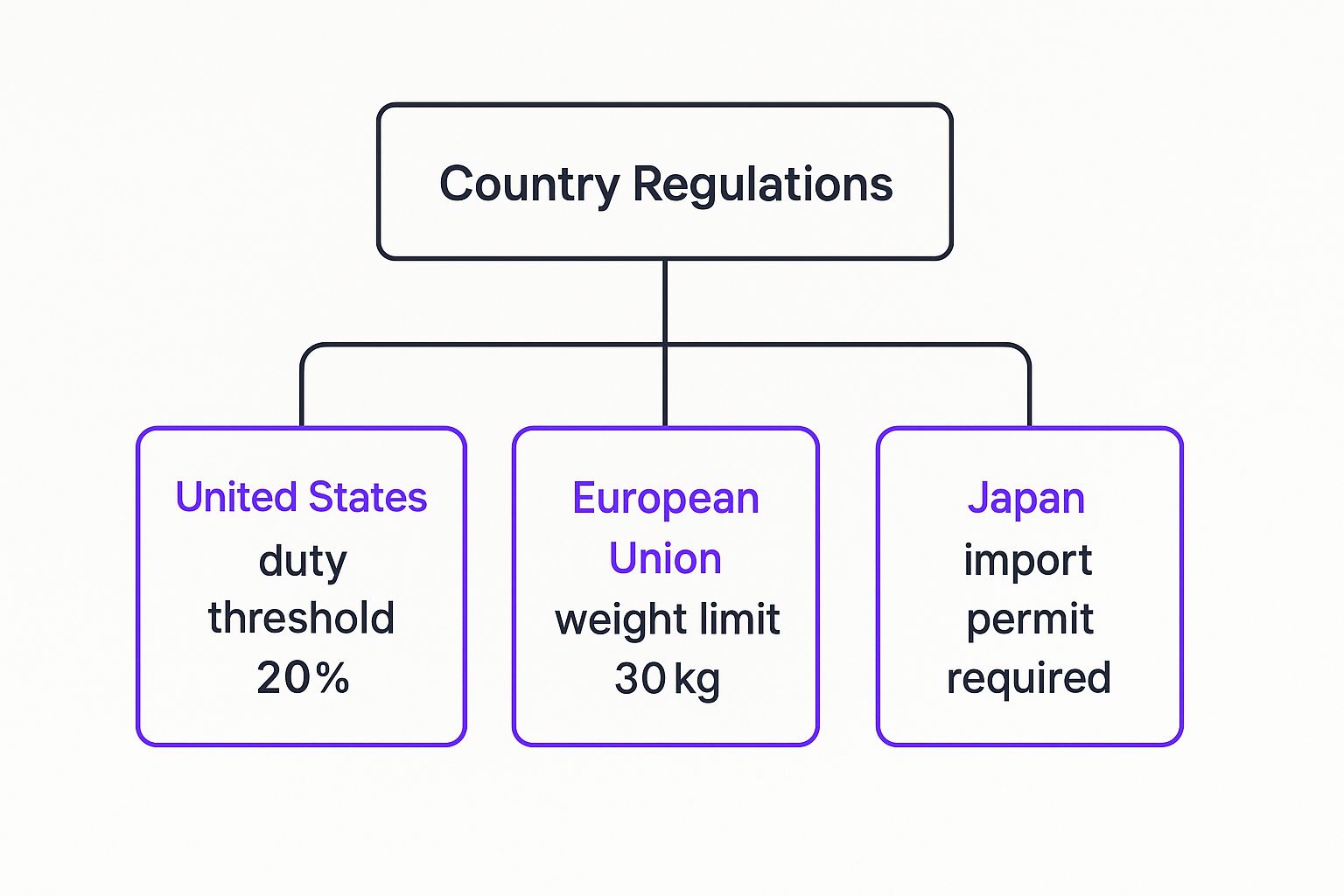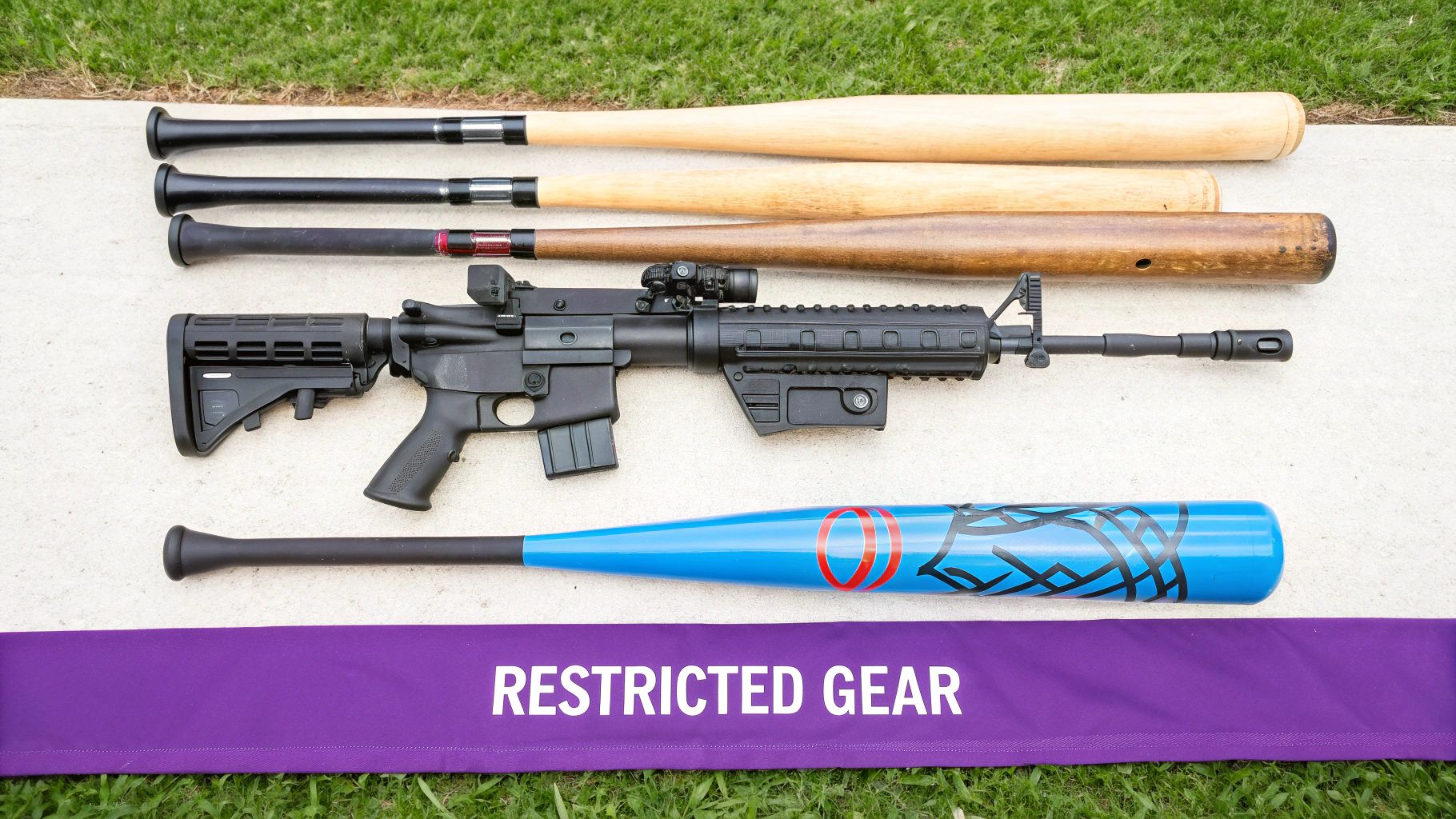
International Shipping Restrictions for Sporting Goods & Outdoor Equipment
Learn about international shipping restrictions for sporting goods and outdoor equipment. Ensure smooth delivery worldwide with our comprehensive guide.
Cody Y.
Updated on Sep 22, 2025
Shipping sporting goods across borders feels like playing a game where every country has its own, unwritten rulebook. Critical mistakes often happen at customs, a place where seemingly harmless items—like a tactical knife for camping—get flagged as weapons, oversized gear exceeds invisible limits, or specific materials violate obscure import laws. If you want to avoid seized shipments and angry customers, you have to learn how to play the game.
Why Global Shipping for Sporting Goods Is So Complex
Taking your sporting goods store global is a massive opportunity, but it also throws you into a labyrinth of regulations. Unlike a t-shirt or a coffee mug, sporting and outdoor equipment often falls into categories that get intense scrutiny from customs officials around the world. This isn't just random red tape; it's rooted in legitimate safety, security, and environmental concerns that change dramatically from one nation to the next.
Think of it this way: a high-powered air rifle you sell for sport in the United States could easily be classified as a firearm in Japan. A simple pocket knife that’s essential for a weekend camper might be considered a prohibited weapon in parts of Europe. These aren't fringe cases—they're everyday scenarios that can bring your supply chain to a dead stop.
Key Challenges in Cross-Border E-commerce
A few key factors make this product category a minefield for international sellers. Getting a handle on them is the first step toward building a shipping strategy that doesn't fall apart at the first hurdle.
- Dual-Use Classification: A lot of your inventory—from advanced GPS units to durable outdoor apparel—can have both civilian and military applications. That ambiguity is a huge red flag for export controls.
- Oversized and Heavy Items: Gear like kayaks, bicycles, and weightlifting equipment create logistical puzzles. It's not just about the higher shipping costs; they also face special handling rules and size limits imposed by carriers and destination countries.
- Material-Based Restrictions: The specific wood used in an archery bow or certain chemicals in a gun cleaning kit could be restricted under international agreements like CITES (Convention on International Trade in Endangered Species of Wild Fauna and Flora).
- Brand and Licensing Issues: Sometimes, a brand has an exclusive distribution deal that legally blocks you from selling their products in certain regions. This has nothing to do with customs and everything to do with contract law.
Navigating this web requires more than a good shipping carrier. It demands a real-world understanding of product classification, documentation, and the regulatory mindset of each country you ship to. To truly get a grip on this, you need to understand the whole picture. For a deep dive, check out this complete international supply chain management guide. This isn't just about getting a package from Point A to B—it's about making sure it arrives legally, on time, and without costing you a fortune in unexpected fees. Mastering this process turns a potential compliance nightmare into a serious competitive advantage.
Why Sporting Goods Face Unique Shipping Hurdles

Shipping a book or a t-shirt is simple. But sending sporting goods and outdoor gear internationally? That’s a whole different ball game. To a customs official, a camping knife isn't just a tool, and a high-end bicycle isn't just for recreation. They see potential weapons, oversized cargo, or products made from restricted materials.
This intense scrutiny is precisely why so many sporting goods shipments get snagged at the border, leading to delays, fines, or outright rejections. These aren't just random rules; they're rooted in legitimate concerns about safety, security, and environmental protection. Getting a handle on why these restrictions exist is the first real step toward building a global shipping strategy that actually works.
The Problem of Dual-Use Classification
One of the biggest tripwires is the concept of "dual-use items." This is a government term for products that have a perfectly normal civilian purpose but could also have a military or tactical application.
Think about a high-end GPS device for hiking. To your customer, it's for finding their way on a trail. To a customs agent, it could theoretically be used for military navigation, which immediately puts it under tight export controls in places like the United States. A tactical survival knife is another classic example. It's a fantastic piece of outdoor equipment, but in a country with strict weapon laws, it’s just a prohibited knife. This ambiguity forces officials to err on the side of caution—usually at your expense.
Key Takeaway: The "dual-use" label means your product's potential function can matter more than its intended function. This is a crucial distinction that trips up countless sellers and is a core reason for so many international shipping roadblocks.
Material and Chemical Regulations
It’s not just what an item does, but what it’s made of that can cause serious headaches. International agreements are in place to protect endangered species and control the movement of hazardous substances, and these rules hit the sporting goods industry hard.
Here are a few common material-based restrictions you might run into:
- CITES-Protected Materials: The Convention on International Trade in Endangered Species (CITES) keeps a close watch on products made from protected plants and animals. This could be anything from exotic woods used in custom archery bows to specific leathers in high-end gear.
- Chemical Components: Things like gun cleaning kits, waterproofing sprays, and even some fire starters contain chemicals that are classified as hazardous materials (hazmat). Shipping these requires special declarations, unique packaging, and carrier approvals that standard products don't need.
- Animal Products: Items that contain feathers, like those used in fly fishing lures or traditional arrows, can be restricted to prevent the spread of diseases such as avian flu.
To navigate this minefield, sellers need a solid grasp of the different types of shipping restrictions that can apply based on what their products are made of.
Size and Weight: The Unseen Barriers
Finally, there’s the obvious but often underestimated challenge: bulky and heavy items. You can’t just pop a canoe, a bicycle, or a set of barbells into a standard box. These products almost always blow past the dimensional weight (DIM weight) and physical size limits for major carriers like DHL, FedEx, and UPS.
This creates a few major problems. First, shipping costs can go through the roof, pricing your products out of the market for international buyers. Second, your choice of carriers shrinks dramatically, as only specialized freight services might be willing to handle the shipment. And sometimes, a country's own infrastructure or import policies simply won't allow oversized goods, period.
The global trade environment is only getting more complex. A recent McKinsey report found that 84% of sporting goods executives are worried about how geopolitics will affect their business, pointing to tariffs and supply chain headaches. In response, smart companies are finding new suppliers and using automation to get a handle on these tough shipping rules. You can read more about these industry trends and the new balancing act for sporting goods.
Understanding Key Market Restrictions by Region
Shipping sporting goods internationally isn’t a one-size-fits-all game. If you treat every major market the same, you’re setting yourself up for seized packages, angry customers, and a logistical nightmare. Successfully navigating the rules in North America, the European Union, and Asia means understanding that each region has its own priorities and red tape.
Think of it this way: shipping a simple t-shirt is like driving down a straight highway. But shipping sporting gear is more like navigating a series of complex roundabouts in different countries. Each one has its own signs, lane rules, and exits—and without a local map for each, you're going to get stuck.

As you can see, some regions are laser-focused on financial details like duty thresholds, while others put a heavy emphasis on permits and physical limits like package weight.
Navigating North American Regulations
The United States is a massive market, but it's also wrapped in a complex web of federal agencies that oversee imports. U.S. Customs and Border Protection (CBP) acts as the main gatekeeper, but other groups like the Consumer Product Safety Commission (CPSC) hold a lot of power.
For instance, any protective gear like ski or bicycle helmets absolutely must meet strict CPSC safety standards. Your shipments can be stopped and tested at the border, and if they fail, they’re getting sent right back. That means you need documentation proving your products are compliant before they ever leave your warehouse.
The U.S. is a major player in the global trade of sporting goods, and shipping rules directly impact the flow of products. In mid-2025, U.S. goods imports, including sports equipment, hit $337.5 billion in June alone, with exports at $277.3 billion, leaving a trade deficit of $60.2 billion. These numbers show just how much product is moving—and how evolving customs regulations can affect prices and availability for American consumers.
The European Union: A Unified Market with Local Twists
At first glance, the European Union (EU) seems simpler thanks to its unified customs framework. Once a product clears customs in one EU country, it can typically move freely across the other member states. But don't let that fool you.
The biggest mistake sellers make is assuming one set of rules applies to all 27 member countries. While customs procedures are harmonized, specific product laws—especially concerning items that could be considered weapons—are not.
Individual countries still have the final say on certain products. Here are a few examples:
- Germany: Home to some of the strictest knife laws in Europe. Many common camping or hunting knives that are perfectly legal elsewhere are flat-out prohibited.
- Italy: Has specific regulations on airsoft guns and high-powered air rifles that often require special import permits.
- France: Keeps tight controls on any gear that could be considered tactical or for self-defense.
Getting a handle on these different rulebooks is essential. Reading up on the international regulations for various types of equipment can give you a solid framework for understanding just how much rules can vary from one border to the next.
To give you a clearer picture, here’s a quick breakdown of what to watch out for in major markets.
Common Shipping Restrictions by Major Market Region
| Region | Commonly Restricted Items | Primary Regulatory Concern | Example Scenario |
|---|---|---|---|
| European Union | Hunting knives, high-power air rifles, tactical gear | Public safety, anti-terrorism laws | Shipping a hunting knife to Germany that is legal in France, only to have it seized by German customs for violating local blade laws. |
| North America | Protective gear (helmets), firearms accessories, certain supplements | Consumer safety standards (CPSC), firearm laws (ATF) | A shipment of ski helmets is detained by U.S. Customs for random CPSC testing and refused entry because the compliance paperwork is missing. |
| Asia | Drones, high-tech electronics, wooden goods | National security, quality control (CCC mark), biosecurity | An order of hiking poles with cork handles is held up in Japanese customs because it lacks a phytosanitary certificate to prove it’s pest-free. |
This table just scratches the surface, but it highlights how a single product category can face completely different hurdles depending on its destination.
Decoding Key Asian Markets
Asia isn't one market; it's an incredibly diverse collection of countries where regulations can change on a dime. Places like China, Japan, and South Korea each have their own specific import requirements that reflect their unique economic and cultural priorities.
China, for example, is known for its notoriously complex customs system, run by the General Administration of Customs of China (GACC). High-value sporting goods often need a China Compulsory Certification (CCC) mark—a safety and quality stamp that can be a long and expensive process to get.
Meanwhile, Japan’s customs officials are legendary for their attention to detail. Your paperwork has to be perfect, and product descriptions need to be incredibly precise. If you're shipping outdoor gear with wooden components, you might need a phytosanitary certificate to prove it's free of pests.
It’s these granular location-based shipping rules that automated tools are built to handle, stopping costly mistakes before an order is even placed. Without a deep understanding of these local nuances, sellers risk their products getting stuck in regulatory limbo forever.
Getting Customs Forms and HS Codes Right

Think of your customs documentation as your shipment's passport. If it isn't perfect, it's not getting through the border. Flawless paperwork is the single most important factor in preventing delays, and for sporting goods, this process demands extreme attention to detail. Get it right, and your package sails through customs. Get it wrong, and you’re looking at delays, fines, and very unhappy customers.
The two main documents you'll be dealing with are the CN22/CN23 customs declarations for postal shipments and the commercial invoice for couriers. They both do the same job: telling customs officials exactly what's inside the box, what it's worth, and where it came from. Vague descriptions like "Outdoor Gear" are a guaranteed recipe for a customs inspection.
What Is This Harmonized System (HS) Code, Anyway?
At the heart of all this paperwork is the Harmonized System (HS) Code. It’s a standardized numerical system for classifying every product imaginable, used by customs authorities worldwide to figure out what duties and taxes apply. It's basically the universal language of global trade.
Every single product has a specific HS code, which is a six-to-ten-digit number that describes it in minute detail. For anyone selling sporting goods, picking the correct code isn't just a suggestion—it's non-negotiable. Using the wrong one isn't a simple mistake; customs officials see it as a misdeclaration, and that can bring serious penalties.
For instance, a snowboard and a pair of water skis might both seem like "sporting equipment," but to a customs agent, they're entirely different worlds.
- Snowboards: Fall under HS Code 9506.11
- Water skis, surfboards, and other water-sport equipment: Fall under HS Code 9506.29
That tiny difference in the last two digits changes everything—how the item is treated, taxed, and regulated. A mistake that small can bring your entire shipment to a grinding halt.
How to Find the Correct HS Code
Finding the right HS code for your products might seem intimidating, but it's a manageable process. The goal is to be as specific as possible to avoid any ambiguity that might flag your package for a manual review.
Here’s a simple, step-by-step way to classify your sporting goods:
- Start with the Chapter: The HS system is organized into chapters. You’ll find most of your products in Chapter 95, which covers "Toys, Games and Sports Requisites; Parts and Accessories Thereof."
- Drill Down to the Heading: Within that chapter, find the four-digit heading that best describes your item. For example, 9506 is the heading for "Articles and equipment for general physical exercise, gymnastics, athletics, other sports... or outdoor games."
- Identify the Subheading: Finally, lock in the six-digit subheading that provides the ultimate specificity. This is where you distinguish between a snowboard (9506.11) and other gear.
You can make this a lot easier by using government tariff lookup tools or your shipping carrier’s online resources. Once you find the codes for your products, document them. Consistency across all your shipments is key.
Crucial Insight: The specificity of an HS code directly impacts duties and taxes. Misclassifying a high-end carbon fiber bicycle frame under a generic "bicycle parts" code could result in paying the wrong tariff rate, either costing you money or alerting customs to a compliance issue.
Mastering this process is fundamental to overcoming the international shipping restrictions for sporting goods and outdoor equipment. Accurate customs declarations, built around precise HS codes, transform a major compliance headache into a smooth, predictable part of your global operations. It’s the difference between a successful delivery and a costly return.
How Automation Fixes Global Shipping Compliance
Let's be honest: manually trying to keep up with the tangled mess of international shipping restrictions for sporting goods and outdoor equipment just doesn't work anymore. The rules are a mile long, they change constantly, and one mistake can cost you a seized shipment, a massive fine, or a customer you'll never get back. This is where automation stops being a "nice-to-have" and becomes a core part of your strategy.
Think of it like a digital bouncer at your checkout. Instead of you frantically checking a customer's address against a messy spreadsheet, an automated system does the work in a split second. It looks at the cart, sees the destination country, and instantly checks everything against a live database of global rules. If a certain hunting knife is banned in Germany, the system simply won't let the order go through.
The Power of Being Proactive
This real-time check is the secret sauce. It stops the most common—and most expensive—shipping headaches before they even start, making sure you never promise a customer something you can't legally deliver.
Global trade is always shifting, and this tech helps you keep up. For instance, trade policies are constantly changing the game for sporting goods. In 2023, the United States shot past the UK to become the top destination for EU sporting goods, grabbing 23.4% of all exports. You can dig into these European trade dynamics on ec.europa.eu. Moves like this show exactly why you need an automated system that adapts on the fly, without you having to micromanage it.
A good compliance dashboard gives you a bird's-eye view of every restricted order attempt and how the system is working.
This isn't just data; it's peace of mind. You can see, at a glance, how automation is actively protecting your business from bad orders.
What You Actually Get with an Automated System
Putting an automated solution in place gives you real, tangible results that change how you manage international sales from day one.
- Slash Your Risk: Automated checks get rid of human error, which is the number one cause of compliance mistakes. That means a much lower chance of dealing with seized packages and legal trouble.
- Happier Customers: When you tell a customer before they pay that an item can't ship to them, you save them a world of frustration. No more canceled orders or angry emails. This kind of transparency builds serious trust.
- Get Your Time Back: Your team can finally stop the soul-crushing work of researching rules for every single product and every single country. All that time can go back into things that actually grow the business, like marketing and talking to your customers.
For stores on platforms like WooCommerce, getting these tools up and running is surprisingly simple. Our guide on automated shipping compliance for Woo Commerce stores walks through just how smoothly this tech can plug into your existing setup.
At the end of the day, automation isn't just about dodging bullets. It's about building a smarter, tougher, and more scalable business that's ready to sell anywhere.
Actionable Best Practices for Shipping Outdoor Gear

Knowing the rules for international shipping is one thing; actually navigating dozens of different customs regulations is another. It’s like plotting a cross-continent trek without a map—one wrong turn and you’ll hit costly delays or seized shipments. A straightforward, step-by-step operational checklist turns those headaches into a smooth journey.
More than just dodging fines, these practices build a reputation for predictability and trust. Implement them and you’ll see fewer surprises at the border—and more satisfied customers coming back for seconds.
Audit Your Product Catalog Immediately
Begin by treating your catalog like a high-risk minefield. Inspect every SKU, because hidden compliance issues often lurk in the details. This isn’t busywork—it’s the bedrock of your international shipping strategy.
Look specifically for:
- Potential Dual-Use Items: GPS trackers, tactical knives, even some high-performance fabrics.
- Restricted Materials: Products with exotic woods, certain animal byproducts, or regulated chemicals.
- Oversized or Heavy Goods: Kayaks, bicycles, weight sets that trigger special carrier rules.
This level of scrutiny gives you a clear map of high-risk products, so you can apply precise rules instead of a blanket block that hurts legitimate orders.
Key Insight: A detailed product audit is your first line of defense. By spotting compliance issues in-house, you avoid costly run-ins with customs and keep your customers happy.
Create Transparent and Detailed Shipping Policies
Surprises at checkout are trust-killers. Your international shipping page should be impossible to miss and crystal clear on what you ship—and where.
Be sure to:
- List every country you ship to (and those you don’t).
- Explain why certain items are restricted by region.
- Provide real-world examples, e.g., “We can’t ship knives to Germany due to local regulations.”
This upfront honesty streamlines support, sets the right expectations, and positions you as a seller who truly understands global commerce.
Frequently Asked Questions
<iframe width="100%" style="aspect-ratio: 16 / 9;" src="https://www.youtube.com/embed/bAKN1WH9MEk" frameborder="0" allow="autoplay; encrypted-media" allowfullscreen></iframe>When you're trying to ship sporting goods and outdoor gear internationally, a few common questions always seem to pop up. Let's tackle them head-on to clear up the confusion and help you ship with more confidence.
What’s the Biggest Mistake Sellers Make When Shipping Outdoor Gear?
The single most common—and expensive—mistake is getting lazy with HS Codes on customs forms. It’s a classic error that’s easy to avoid.
For example, just writing "sporting equipment" for a high-performance hunting bow is a huge red flag for customs officials. They need specifics. Using the correct HS code (9506.99) and a detailed description gives them the exact information they need to clear the shipment. A simple oversight like this can cause massive delays, surprise fines, or even get the whole package sent back to you on your own dime.
Can I Ship Products with Lithium Batteries, Like GPS Devices?
Absolutely, but you have to play by the dangerous goods rulebook. There’s no winging it here.
Lithium batteries demand special handling. This includes using the right labels (like the UN3481 label) and making sure the battery is already installed inside the device. You also have to use a carrier that’s actually certified to handle dangerous goods—your standard postal service will likely refuse these items outright. Fail to declare these properly, and you’re looking at serious penalties for a major safety violation.
The core value of an automated compliance tool is its ability to stay current. These platforms constantly update their databases to reflect the latest international laws, shifting carrier policies, and country-specific rules, turning a massive research burden into a seamless and reliable process.
How Does an Automated Tool Keep Up with Constantly Changing Rules?
This is where automation really shines. Instead of tasking your team with the impossible job of tracking regulatory updates across dozens of countries, the software handles it for you.
An automated platform's database is constantly refreshed with the latest laws and carrier policies. When a customer goes to check out, the system applies the most current rules in real time. This flips compliance from a reactive headache into a proactive, dependable system that shields your business from costly errors and sudden shifts in global trade.
Stop losing sales to shipping confusion and protect your business from costly compliance mistakes. Ship Restrict automates your shipping rules, blocking prohibited orders in real-time and giving you peace of mind. Learn more and get started at Ship Restrict.

Cody Yurk
Founder and Lead Developer of ShipRestrict, helping e-commerce businesses navigate complex shipping regulations for regulated products. Ecommerce store owner turned developer.